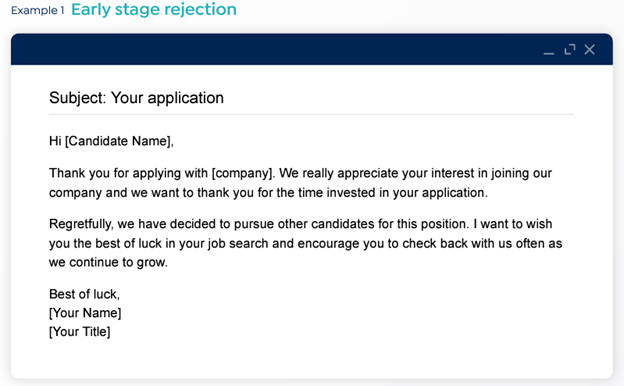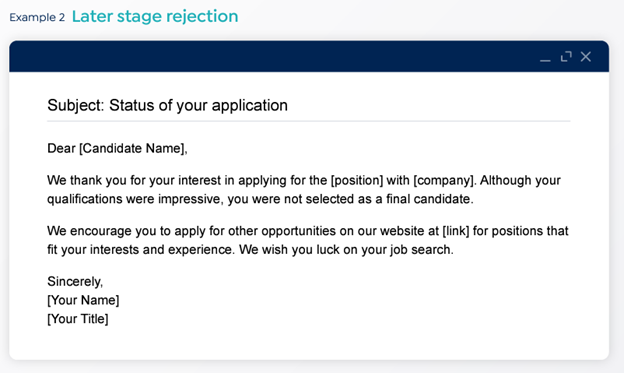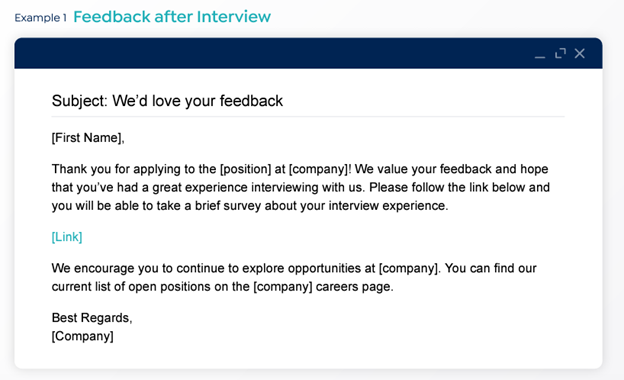In the competitive world of hiring, something that often gets overlooked is the rather delicate task of delivering candidate rejection. While it may be difficult or awkward, approaching this process with care has a positive impact on candidates, even if they are disappointed they weren’t selected.
Not only does this positive impression improve the likelihood of rejected candidates applying to other openings down the line, but it also leaves them feeling respected and valued by your company.
Let’s explore some strategies to gracefully deliver candidate rejection, with the goal of turning a potentially negative experience into an opportunity to build relationships and maintain a positive employer brand.
1. Provide Transparent and Timely Communication
Ghosting candidates has become a common practice that can leave candidates feeling lead on and disheartened. Perhaps employers believe that ghosting is a gentler than a direct rejection email, but in reality, it’s more likely to lead to frustration. As highlighted in our 2023 Candidate Experience Report, 39% of candidates have experienced ghosting by an employer or recruiter in the past year alone.
Remember that candidates who you don’t hire can still have an impact on your employer brand. Candidates who have a negative experience with your hiring process are able to share this experience publicly and it can impact the quality and quantity of candidates who enter your hiring pipeline.
Instead of ghosting, prioritize transparency by promptly informing candidates within a day or two if they are no longer in the running for the job. Delays can heighten anxiety and uncertainty, negatively impacting the candidate's perception of your company.
By respecting their time and providing honest communication, you demonstrate your commitment to treating candidates with fairness and professionalism.Take a hard look at your entire recruitment funnel to uncover the gaps in communications and identify places where candidates are slipping through the cracks.
To fill those gaps, you can rely on automated emails (like SmartRecruiters’ SmartMessage and SmartPal platforms) to ensure that candidates are consistently getting the updates they deserve. If you use an ATS, you can program emails to be sent to candidates as they progress through your talent pipeline to keep them in the know.
2. Deliver Constructive Feedback
Candidates greatly appreciate feedback because it helps them learn from their experience and improve their chances of getting hired in the long run. Ideally, they want to know where they “went wrong” and what they could have done better to get selected for the role.
However, sharing precise reasoning for hiring decisions poses legal risks. A good balance is to provide hiring managers with templated responses they can use when candidates request more feedback. These guidelines ensure that candidates receive constructive input while keeping your company protected from potential legal issues.
You can also consider sharing assessment findings by providing candidate-friendly reports (like Criteria’s Workplace Insights Report), which offer valuable insights for their ongoing job search. These reports can serve as a strategic tool that allow candidates to showcase their strengths and traits effectively. By leveraging these insights and better understanding their strengths and areas for improvement, candidates can confidently present their best selves in future job applications.
3. Make it Personalized
Nothing says ‘’we don’t care about you’’ more than a generic rejection email or pre-recorded cold phone call. When delivering rejection, always personalize the message by including the candidate's name and, if feasible, referencing aspects discussed during the interview.
A generic rejection email is easily recognized and feels impersonal. Tailor your message to each candidate, expressing gratitude for their interest in your company. Being specific shows that you appreciate their unique skills, and acknowledging their individual contributions demonstrates genuine recognition of their value.
Because rejections can occur at any point along the recruitment journey, the tone and depth of the message will likely vary based on how far they made it in your hiring process. A rejection at the initial application phase will be polite but concise, while a rejection after the final interview stage should delve into more personalized feedback and appreciation for their time spent interviewing for the role.
Ultimately, adhering to the golden rule – treating others as you want to be treated – lays the groundwork for respectful and considerate communication.
Not sure how to get started? Use the below templates to help craft messages that align with your process, brand, and culture.


4. Offer Feedback Surveys
People want to feel heard. It’s one of the reasons why disgruntled candidates will leave reviews on sites like Glassdoor about their experience with your hiring process. Be proactive in your gathering of candidate feedback instead.
Offer rejected candidates the opportunity to provide feedback through a survey about your hiring process. This not only allows candidates to share their feelings directly with you, but it also reduces the likelihood of them venting their frustrations on public platforms.
Surveys help candidates feel heard and value while providing you with actionable feedback to continuously enhance your candidate experience over time.

Keep Candidate Experience Top of Mind at Every Stage
Delivering candidate rejection with care is an integral part of creating a positive candidate experience.
By prioritizing transparent communication,providing constructive feedback, and offering post-recruitment surveys, you demonstrate your commitment to clear communication and respectful treatment of candidates, fostering a strong employer brand. Remember: the candidate you reject today could be a successful hire in the future, so make every interaction count.
Looking to elevate your candidate experience, but don’t know where to start? Check out our Candidate Communications Toolkit with 20+ easy and ready to use email templates!





